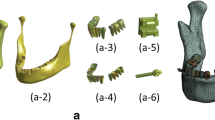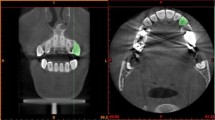Abstract
Excessive forces may cause root resorption and insufficient forces would introduce no effect in orthodontics. The objective of this study was to investigate the optimal orthodontic forces on a maxillary canine, using hydrostatic stress and logarithmic strain of the periodontal ligament (PDL) as indicators. Finite element models of a maxillary canine and surrounding tissues were developed. Distal translation/tipping forces, labial translation/tipping forces, and extrusion forces ranging from 0 to 300 g (100 g=0.98 N) were applied to the canine, as well as the force moment around the canine long axis ranging from 0 to 300 g·mm. The stress/strain of the PDL was quantified by nonlinear finite element analysis, and an absolute stress range between 0.47 kPa (capillary pressure) and 12.8 kPa (80% of human systolic blood pressure) was considered to be optimal, whereas an absolute strain exceeding 0.24% (80% of peak strain during canine maximal moving velocity) was considered optimal strain. The stress/strain distributions within the PDL were acquired for various canine movements, and the optimal orthodontic forces were calculated. As a result the optimal tipping forces (40–44 g for distal-direction and 28–32 g for labial-direction) were smaller than the translation forces (130–137 g for distal-direction and 110–124 g for labial-direction). In addition, the optimal forces for labialdirection motion (110–124 g for translation and 28–32 g for tipping) were smaller than those for distal-direction motion (130–137 g for translation and 40–44 g for tipping). Compared with previous results, the force interval was smaller than before and was therefore more conducive to the guidance of clinical treatment. The finite element analysis results provide new insights into orthodontic biomechanics and could help to optimize orthodontic treatment plans.
中文概要
目的
探究上颌尖牙在不同移动方式下的最佳正畸力。
创新点
综合考虑牙周膜的静水压应力和对数应变,进一步优化尖牙移动的最佳正畸力区间。
方法
对尖牙施加范围在0~300 g(100 g=0.98 N)的远中向、唇向和拔出向的整体移动力和倾斜移动力,以及范围在0~300 g·mm 的绕尖牙牙长轴向的扭转力矩,通过非线性有限元分析对牙周膜的应力应变进行定量评价。约定牙周膜应力在0.47 kPa(毛细血管压力)至12.8 kPa(人类心脏收缩压力的80%)之间的为最佳应力;以及牙周膜应变大于0.24%(尖牙最大移动速度时的牙周膜应变的80%)为最佳应变。
结论
尖牙倾斜移动时的最佳正畸力范围(远中向为 40~44 g,唇向为28~32 g)小于其整体移动(远 中向为130~137 g,唇向为110~124 g);尖牙远 中向移动时的最佳正畸力范围(整体移动为 110~124 g,倾斜移动为28~32 g)小于其唇向移 动(整体移动为130~137 g,倾斜移动为40~44 g)。 与已有的研究结果相比,最佳正畸力范围进一步 缩小,对临床正畸治疗具有较好的指导意义。
Similar content being viewed by others

References
Anneke N, John DC, Tom L, et al., 2017. Importance of the variable periodontal ligament geometry for whole tooth mechanical function: a validated numerical study. J Mech Behav Biomed, 67:61–73. https://doi.org/10.1016/j.jmbbm.2016.11.020
Burstone CJ, Pryputniewicz RJ, 1980. Holographic determination of centers of rotation produced by orthodontic forces. Am J Orthod, 77(4):396–409. https://doi.org/10.1016/0002-9416(80)90105-0
Chen JN, Li W, Swain MV, et al., 2014. A periodontal ligament driven remodeling algorithm for orthodontic tooth movement. J Biomech, 47(7):1689–1695. https://doi.org/10.1016/j.jbiomech.2014.02.030
Choy K, Pae EK, Park Y, et al., 2000. Effect of root and bone morphology on the stress distribution in the periodontal ligament. Am J Orthod Dentofacial Orthop, 117(1): 98–105. https://doi.org/10.1016/S0889-5406(00)70254-X
Dorow C, Sander FG, 2005. Development of a model for the simulation of orthodontic load on lower first premolars using the finite element method. J Orofac Orthop, 66(3): 208–218. https://doi.org/10.1007/s00056-005-0416-5
Field C, Ichim I, Swain MV, et al., 2009. Mechanical responses to orthodontic loading: a 3-dimensional finite element multi-tooth model. Am J Orthod Dentofacial Orthop, 135(2):174–181. https://doi.org/10.1016/j.ajodo.2007.03.032
Han G, Huang SF, Vonden-Hoff JW, et al., 2005. Root resorption after orthodontic intrusion and extrusion: an intraindividual study. Angle Orthod, 75(6):912–918.
Hemanth M, Raghuveer HP, Rani MS, et al., 2015. An analysis of the stress induced in the periodontal ligament during extrusion and rotation movements—Part II: a comparison of linear vs nonlinear FEM linear study. J Contem Dent Pract, 16(10):819–823. https://doi.org/10.5005/jp-journals-10024-1763
Hohmann A, Wolfram U, Geiger M, et al., 2007. Periodontal ligament hydrostatic pressure with areas of root resorption after application of a continuous torque moment. Angle Orthod, 77(4):653–659.
Hohmann A, Wolfram U, Geiger M, et al., 2009. Correspondences of hydrostatic pressure in periodontal ligament with regions of root resorption: a clinical and a finite element study of the same human teeth. Comput Methods Programs Biomed, 93(2):155–161. https://doi.org/10.1016/j.cmpb.2008.09.004
Huang HX, Tang WC, Yan B, et al., 2016. Mechanical responses of the periodontal ligament based on an exponential hyperelastic model: a combined experimental and finite element method. Comput Method Biomech, 19(2): 188–198. https://doi.org/10.1080/10255842.2015.1006207
Kim T, Suh J, Kim N, et al., 2010. Optimum conditions for parallel translation of maxillary anterior teeth under retraction force determined with the finite element method. Am J Orthod Dentofacial Orthop, 137(5):639–647. https://doi.org/10.1016/j.ajodo.2008.05.016
Li ZJ, 2014. Oral orthodontic force simulation and tooth movement modulation research. MS Thesis, Harbin Institute of Technology, Harbin, China (in Chinese).
Liao ZP, Chen JN, Li W, et al., 2016. Biomechanical investigation into the role of the periodontal ligament in optimizing orthodontic force: a finite element case study. Arch Oral Biol, 66:98–107. https://doi.org/10.1016/j.archoralbio.2016.02.012
Lombardo L, Stefanoni F, Mollica F, et al., 2012. Three dimensional finite-element analysis of a central lower incisor under labial and lingual loads. Prog Orthod, 13(2): 154–163. https://doi.org/10.1016/j.pio.2011.10.005
Natali AN, Pavan PG, Carniel EL, et al., 2004. Viscoelastic response of the periodontal ligament: an experimentalnumerical analysis. Connect Tissue Res, 45(4-5):222–230. https://doi.org/10.1080/03008200490885742
Rygh P, 1973. Ultrastructural changes in pressure zones of human periodontium incident to orthodontic tooth movement. Acta Odontol Scand, 31(2):109–122.
Toms SR, Eberhardt AW, 2003. A nonlinear finite element analysis of the periodontal ligament under orthodontic tooth loading. Am J Orthod Dentofacial Orthop, 123(6): 657–665. https://doi.org/10.1016/S0889-5406(03)00164-1
Oskui IZ, Hashemi A, 2016. Dynamic tensile properties of bovine periodontal ligament: a nonlinear viscoelastic model. J Biomech, 49(5):756–764. https://doi.org/10.1016/j.jbiomech.2016.02.020
Oskui IZ, Hashemia A, Jafarzadehb H, 2016. Biomechanical behavior of bovine periodontal ligament: experimental tests and constitutive model. J Mech Behav Biomed Mater, 62:599–606. https://doi.org/10.1016/j.jmbbm.2016.05.036
Parker PJ, Harris EF, 1998. Directions of orthodontic tooth movements associated with external apical root resorption of the maxillary central incisor. Am J Orthod Dentofacial Orthop, 114(6):677–683. https://doi.org/10.1016/S0889-5406(98)70200-8
Provatidis CG, 2000. A comparative FEM-study of tooth mobility using isotropic and anisotropic models of the periodontal ligament. Med Eng Phys, 22(5):359–370. https://doi.org/10.1016/S1350-4533(00)00055-2
Qian H, Chen J, Katona TR, 2001. The influence of PDL principal fibers in a 3-dimensional analysis of orthodontic tooth movement. Am J Orthod Dentofacial Orthop, 120(3): 272–279. https://doi.org/10.1067/mod.2001.116085
Qian YL, Fan YB, Liu Z, et al., 2008. Numerical simulation of tooth movement in a therapy period. Clin Biomech, 23(S1):S48–S52. https://doi.org/10.1016/j.clinbiomech.2007.08.023
Rohan M, Laxmikanth C, Satish S, et al., 2015. A comparative study of forces in labial and lingual orthodontics using finite element method. J Indian Orthod Soc, 49(1):15–18. https://doi.org/10.4103/0301-5742.158628
Rudolph DJ, Willes PMG, Sameshima GT, 2001. A finite element model of apical force distribution from orthodontic tooth movement. Angle Orthod, 71(2):127–131.
Storey E, Smith R, 1952. Force in orthodontics and its relation to tooth movement. Aust Dent J, 56:11–18.
Toms SR, Dakin GJ, Lemons JE, et al., 2002. Quasi-linear viscoelastic behavior of the human periodontal ligament. J Biomech, 35(10):1411–1415. https://doi.org/10.1016/S0021-9290(02)00166-5
Wei ZG, Yu XL, Xu XG, et al., 2014. Experiment and hydromechanical coupling simulation study on the human periodontal ligament. Comput Methods Programs Biomed, 113(3):749–756. https://doi.org/10.1016/j.cmpb.2013.12.011
Wilson AN, Middleton J, Jones ML, et al., 1994. The finite element analysis of stress in the periodontal ligament when subject to vertical orthodontic forces. Br J Orthod, 21(2):161–167.
Author information
Authors and Affiliations
Corresponding author
Additional information
Project supported by the National Natural Science Foundation of China (Nos. 51375453 and 51775506) and the Natural Science Foundation of Zhejiang Province (No. LY18E050022), China
Electronic supplementary materials: The online version of this article (https://doi.org/10.1631/jzus.B1700195) contains supplementary materials, which are available to authorized users
Electronic supplementary material
11585_2018_195_MOESM1_ESM.pdf
A biomechanical case study on the optimal orthodontic force on the maxillary canine tooth based on finite element analysis
Rights and permissions
About this article
Cite this article
Wu, Jl., Liu, Yf., Peng, W. et al. A biomechanical case study on the optimal orthodontic force on the maxillary canine tooth based on finite element analysis. J. Zhejiang Univ. Sci. B 19, 535–546 (2018). https://doi.org/10.1631/jzus.B1700195
Received:
Revised:
Accepted:
Published:
Issue Date:
DOI: https://doi.org/10.1631/jzus.B1700195



